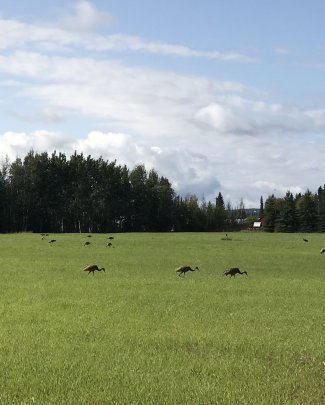Cohort 1: Non-rural Children
Fall 2018/Spring 2019
Teaching children about sandhill cranes: During the first class nature tours, a group of 5-6 preschool children took off running across the barley field, chasing after sandhill cranes. While some chased for the fun of scaring them, one stated that she wanted to “kill them.” Creamer’s field was developed to be a wildlife bird refuge where migrating birds rest and eat during their long migration from the Arctic to Mexico. The children were taught the importance of not disturbing the birds as well as their migration patterns, sources of food and overall physique and attributes of the fowl.

What did you learn about sandhill cranes?
John: “They stand on one foot sleeping.”
Jennifer: “That they have beaks. Stay on the trail.”
Daniel: “They fly to Mexico.”
David: “You don’t have to run. I learned everyone has a little wild. Not to go in the fields of the sandhill cranes.”
Brittany: “They have beaks.”
Robert: “Nothing.”
Joseph: “The grass has cereal.”
Stephanie: “Cereal in the grass because the grass is like cereal.”
Jessica: “The cranes eat cereal. They know each other from long time ago because they be together.”
Justin: “Mexico."
Tracking Animals in the snow. Learning to observe signs of other animal inhabitants helps children develop a sense of empathy in an environment. Graduate Research Assistant, Dana Lindauer, developed a lesson to teach children how to identify animal tracks in the snow during their March 2019 visit to Creamer's Field. Children were observed applying their understanding through investigating tracks that they came across during their exploration.
Finding the Little House. During children’s exploration of the forest, the teacher promoted a sense of spatial autonomy environmental competency by pointing out a “Little House,” an animal’s burrow in a birch tree. This informal interaction with the teacher, promotes children’s curiosity, respect and appreciation of animal homes in the forest.
Cohort 2: Rural Children
Fall 2019
Sharing on the Tundra. The children's bicultural teacher accompanied them on their field trip to the tundra. The teacher showed the children the different berries, where to find them, and how to pick them. As children gain environmental competency, they will learn to appreciate and respect the land for the sustenance it provides them. Importantly, the teacher also demonstrated the value of actively sharing berries with others. This value of sharing is deeply important in Iñupiaq culture, as a practice of respect and reciprocity. Reciprocity is practiced both with the human and non-human world, and so this act of sharing with others is an extension of an ethic that emphasizes empathy for all living things.
This project is funded by the National Science Foundation. Award # 1753399, CAREER: A longitudinal study of the emotional and behavioral processes of Environmental Identity Development among rural and non-rural Alaskan children

